Wikipedia:Picture of the day/June 2020
|
Featured picture tools: |
These featured pictures, as scheduled below, appeared as the picture of the day (POTD) on the English Wikipedia's Main Page in June 2020. Individual sections for each day on this page can be linked to with the day number as the anchor name (e.g. [[Wikipedia:Picture of the day/June 2020#1]] for June 1).
You can add an automatically updating POTD template to your user page using {{Pic of the day}} (version with blurb) or {{POTD}} (version without blurb). For instructions on how to make custom POTD layouts, see Wikipedia:Picture of the day.Purge server cache
June 1

|
The southern plains gray langur (Semnopithecus dussumieri) is a species of Old World monkey native to the Indian subcontinent. It is about 62 cm (24 in) tall and lives in groups in various forest habitats, feeding mainly on leaves, fruit and flowers in the canopy, supplementing these with insects, gum, grasses, herbs and roots. The monkeys are considered sacred in India, and some are used by Hindu priests for religious purposes. They have adapted to living in close proximity to humans in urban settings; they are often fed by humans and accept cakes, millet, and other foods. The species is protected by law in India, but some are still persecuted for damaging crops, hunted for food and captured for pets. This photograph of a female southern plains gray langur was taken in Kanha Tiger Reserve, in the Indian state of Madhya Pradesh. The park was created on 1 June 1955 and was designated a tiger reserve in 1973. Photograph credit: Charles J. Sharp |
June 2
Subpage 1
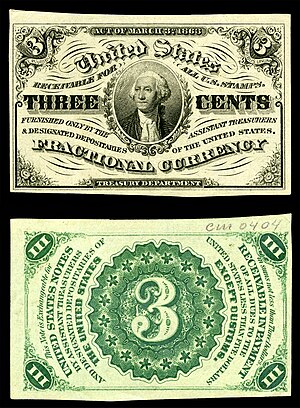
|
Fractional currency, also referred to as shinplasters, was introduced by the United States federal government following the outbreak of the Civil War. These low-denomination banknotes of the U.S. dollar were in use between 21 August 1862 and 15 February 1876; they were issued in denominations of 3, 5, 10, 15, 25 and 50 cents across five issuing periods. The notes could be redeemed by the U.S. Postal Service for the face value in postage stamps. This picture shows a third-issue three-cent fractional currency note, issued by the United States Department of the Treasury between 5 December 1864 and 16 August 1869, featuring a portrait of George Washington, the first president of the United States, on the obverse. This banknote is in the National Numismatic Collection of the Smithsonian Institution's National Museum of American History. Banknote design credit: United States Department of the Treasury; photographed by the National Numismatic Collection
Recently featured:
|
Subpage 2

|
Fractional currency, also referred to as shinplasters, was introduced by the United States federal government following the outbreak of the Civil War. These low-denomination banknotes of the U.S. dollar were in use between 21 August 1862 and 15 February 1876; they were issued in denominations of 3, 5, 10, 15, 25 and 50 cents across five issuing periods. The notes could be redeemed by the U.S. Postal Service for the face value in postage stamps. This picture shows a third-issue five-cent fractional currency note, issued by the United States Department of the Treasury between 5 December 1864 and 16 August 1869, featuring a portrait of Spencer M. Clark, then supervisor of the Currency Bureau, on the obverse. This banknote is in the National Numismatic Collection of the Smithsonian Institution's National Museum of American History. Banknote design credit: United States Department of the Treasury; photographed by the National Numismatic Collection
Recently featured:
|
Subpage 3

|
Fractional currency, also referred to as shinplasters, was introduced by the United States federal government following the outbreak of the Civil War. These low-denomination banknotes of the U.S. dollar were in use between 21 August 1862 and 15 February 1876; they were issued in denominations of 3, 5, 10, 15, 25 and 50 cents across five issuing periods. The notes could be redeemed by the U.S. Postal Service for the face value in postage stamps. This picture shows a third-issue ten-cent fractional currency note, issued by the United States Department of the Treasury between 5 December 1864 and 16 August 1869, featuring a portrait of George Washington, the first president of the United States, on the obverse. This banknote is in the National Numismatic Collection of the Smithsonian Institution's National Museum of American History. Banknote design credit: United States Department of the Treasury; photographed by the National Numismatic Collection
Recently featured:
|
Subpage 4

|
Fractional currency, also referred to as shinplasters, was introduced by the United States federal government following the outbreak of the Civil War. These low-denomination banknotes of the U.S. dollar were in use between 21 August 1862 and 15 February 1876; they were issued in denominations of 3, 5, 10, 15, 25 and 50 cents across five issuing periods. The notes could be redeemed by the U.S. Postal Service for the face value in postage stamps. This picture shows a third-issue twenty-five-cent fractional currency note, issued by the United States Department of the Treasury between 5 December 1864 and 16 August 1869, featuring a portrait of William P. Fessenden, then secretary of the treasury, on the obverse. This banknote is in the National Numismatic Collection of the Smithsonian Institution's National Museum of American History. Banknote design credit: United States Department of the Treasury; photographed by the National Numismatic Collection
Recently featured:
|
Subpage 5

|
Fractional currency, also referred to as shinplasters, was introduced by the United States federal government following the outbreak of the Civil War. These low-denomination banknotes of the U.S. dollar were in use between 21 August 1862 and 15 February 1876; they were issued in denominations of 3, 5, 10, 15, 25 and 50 cents across five issuing periods. The notes could be redeemed by the U.S. Postal Service for the face value in postage stamps. This picture shows a third-issue fifty-cent fractional currency note (one of three variants of this denomination), issued by the United States Department of the Treasury between 5 December 1864 and 16 August 1869, featuring a portrait of Francis E. Spinner, then treasurer of the United States, on the obverse. This banknote is in the National Numismatic Collection of the Smithsonian Institution's National Museum of American History. Banknote design credit: United States Department of the Treasury; photographed by the National Numismatic Collection
Recently featured:
|
Subpage 6

|
Fractional currency, also referred to as shinplasters, was introduced by the United States federal government following the outbreak of the Civil War. These low-denomination banknotes of the U.S. dollar were in use between 21 August 1862 and 15 February 1876; they were issued in denominations of 3, 5, 10, 15, 25 and 50 cents across five issuing periods. The notes could be redeemed by the U.S. Postal Service for the face value in postage stamps. This picture shows a third-issue fifty-cent fractional currency note (one of three variants of this denomination), issued by the United States Department of the Treasury between 5 December 1864 and 16 August 1869, featuring a portrait of Francis E. Spinner, then treasurer of the United States, on the obverse. This banknote is in the National Numismatic Collection of the Smithsonian Institution's National Museum of American History. Banknote design credit: United States Department of the Treasury; photographed by the National Numismatic Collection
Recently featured:
|
Subpage 7

|
Fractional currency, also referred to as shinplasters, was introduced by the United States federal government following the outbreak of the Civil War. These low-denomination banknotes of the U.S. dollar were in use between 21 August 1862 and 15 February 1876; they were issued in denominations of 3, 5, 10, 15, 25 and 50 cents across five issuing periods. The notes could be redeemed by the U.S. Postal Service for the face value in postage stamps. This picture shows a third-issue fifty-cent fractional currency note (one of three variants of this denomination), issued by the United States Department of the Treasury between 5 December 1864 and 16 August 1869, featuring a personification of Justice holding a set of scales on the obverse. This banknote is in the National Numismatic Collection of the Smithsonian Institution's National Museum of American History. Banknote design credit: United States Department of the Treasury; photographed by the National Numismatic Collection
Recently featured:
|
June 3

|
Anna Palm de Rosa (1859–1924) was a Swedish artist and landscape painter. In the 1890s, she was one of Sweden's most popular painters, with her watercolours of steamers, sailing ships and scenes of Stockholm, but she left Sweden for good at the age of 36, marrying an Italian and spending the rest of her life in southern Italy. This painting, dated 1885, shows a game of ombre at Brøndums Hotel, in Skagen in the north of Denmark. The hotel is remembered for its close associations with the late 19th-century artists' colony known as the Skagen Painters. In order to help cover their board and lodgings, some of the artists donated their work to the hotel, where the pictures were displayed on the walls of the dining room. This painting is now in the collection of Skagens Museum. Painting credit: Anna Palm de Rosa
Recently featured:
|
June 4
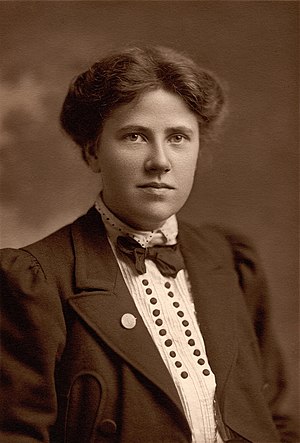
|
Ray Strachey (4 June 1887 – 16 July 1940) was a British feminist politician, mathematician, engineer, artist and writer. For most of her life, Strachey worked for women's suffrage organisations, starting when she was studying mathematics at Cambridge, during which time she took part in the Mud March of February 1907. Her ambition to become an engineer was abandoned when she married Oliver Strachey, a civil servant and cryptographer, in 1911; she continued to take an interest in the role of women in engineering, and campaigned on behalf of the Society of Women Welders in 1920 for women to be permitted to remain in the trade. After World War I, women were granted the vote and permitted to stand for parliament, and she stood as an independent parliamentary candidate in Brentford and Chiswick at the general elections of 1918, 1922 and 1923, without success. Photograph credit: unknown; restored by Adam Cuerden
Recently featured:
|
June 5

|
Perast is an old town on the Bay of Kotor in Montenegro. It is situated a few kilometres northwest of Kotor and is noted for its proximity to the islets of Saint George and Our Lady of the Rocks. Its history dates back to at least 1336, when it was the site of a small fishing village with a shipyard, but over time it became an important maritime centre. It prospered in the 16th century, when it was loyal to the Venetians at a time when the Republic of Venice and the Ottoman Empire were struggling for supremacy in the area. The wealthy merchants and sea captains built themselves grand palaces, mostly in the Baroque style, and there was a renowned naval college. Nowadays, the town relies on tourism for its income, and the number of residents has dwindled; it had a population of 274 at the last census. Photograph credit: Marcin Konsek
Recently featured:
|
June 6

|
Sinustrombus sinuatus, the laciniate conch, is a species of marine gastropod mollusc in the family Strombidae. It is native to the tropical Indo-Pacific region, where it lives on the seabed at depths down to about 20 m (66 ft). This photograph shows apertural (left) and dorsal (right) views of an empty S. sinuatus shell, 83 mm (3.3 in) in length, which may have washed up on a beach. In life, the aperture would be closed by a horny operculum when the animal was not feeding on algae or detritus, or moving about. The operculum and the finger-like processes on the lip of the shell can be used to right itself when it has been overturned, and the operculum and muscular foot are used to flip itself along, in locomotion or defence. Photograph credit: George Chernilevsky
Recently featured:
|
June 7

|
|
Echo and Narcissus is an oil-on-canvas painting by English painter John William Waterhouse, dating from 1903, illustrating the myth of Echo and Narcissus from Ovid's Metamorphoses. The nymph Echo was unable to speak except to repeat the last sentence she had heard. She became infatuated with Narcissus, but he spurned her, instead falling in love with his own reflection in a pool. He continued to gaze at his reflection until he faded away, and a narcissus flower grew on the spot where he died. Echo also pined away, until only her voice remained. Exhibited at the Royal Academy of Arts in 1903, the painting was purchased by the Walker Art Gallery in Liverpool, where it now hangs. Painting credit: John William Waterhouse
Recently featured:
|
June 8

|
Lenin, a Soviet nuclear-powered icebreaker, was both the world's first nuclear-powered surface ship and the first nuclear-powered civilian vessel. The ship entered operation in 1959 and worked to clear sea routes for cargo ships along Russia's northern coast. Nuclear power proved to be an ideal technology for a vessel working in such a remote area, as it obviated the need for regular replenishment of fuel. From 1960 to 1965, the ship covered over 85,000 mi (137,000 km) during the Arctic navigation season, of which three-quarters was through ice. After being decommissioned in 1989, the vessel was subsequently converted into a museum ship and is now permanently based at Murmansk. Photograph credit: Andrew Shiva
Recently featured:
|
June 9

|
Michael Ancher (9 June 1849 – 19 September 1927) was a Danish realist artist, best known for his paintings of fishermen and other scenes from the Danish fishing community in Skagen. Several painters moved to an artist's colony in Skagen each summer, and it was here that he met his wife Anna, who mostly painted interiors and simple themes from the everyday lives of the local people, especially country folk, women and children. The couple settled in the town, and the house in which they once lived has been turned into the Anchers Hus, a museum and gallery, which houses some of their original furniture, and paintings created by them and other Skagen artists. Photograph credit: unknown; restored by Adam Cuerden
Recently featured:
|
June 10

|
James Francis Edward Stuart (10 June 1688 – 1 January 1766), nicknamed the Old Pretender by Whigs, was the son of King James II of England and his second wife, Mary of Modena. The prince's birth was controversial, coming five years after his mother's last pregnancy; rumours began to spread that he was an impostor baby, smuggled into the royal birth chamber in a warming pan and that the actual child of James and Mary was stillborn. In an attempt to scotch this myth, James published the testimonies of over seventy witnesses to the birth. This oil-on-canvas studio portrait, exhibiting French influences, was probably painted in 1712 under the supervision of Alexis Simon Belle, known for his portraits of the French and Jacobite nobility. The painting depicts the young prince wearing the blue ribbon of the Order of the Garter, and now hangs in the National Portrait Gallery in London. Painting credit: studio of Alexis Simon Belle
Recently featured:
|
June 11
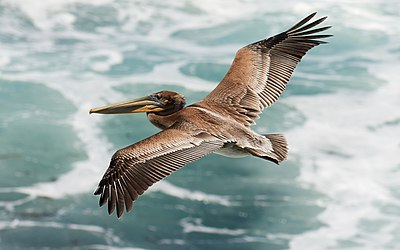
|
The brown pelican (Pelecanus occidentalis) is a bird of the pelican family, Pelecanidae, one of three species found in the Americas and one of two that feed by diving into water. This photograph shows a juvenile brown pelican gliding over the Pacific Ocean at Bodega Head, California. After hatching, the pelican chicks are fed on regurgitated predigested fish and take about two months to fledge. When they leave the nest, they are at first unable to fly and take wing several weeks later. When the parents cease to feed them, some six months later, each will have consumed around 70 kg (150 lb) of fish. The juvenile brown pelican does not acquire adult plumage until three years of age, when the feathers on the neck become paler, the upperparts striped, the wing feathers grayer, and the belly acquires dark spots. Photograph credit: Frank Schulenburg
Recently featured:
|
June 12

|
Mariana is an 1851 oil-on-panel painting by John Everett Millais, depicting a young female character from William Shakespeare's Measure for Measure. In the play, Mariana was engaged to be married, but was rejected when her dowry was lost in a shipwreck. Her story was retold in "Mariana", a poem published in 1830 by Tennyson; Millais's painting includes many details that relate directly to Tennyson's poem. Mariana is depicted in a blue dress and stretching her aching back, having toiled too long on a needlepoint that lies on the table in front of her. The painting now hangs in Tate Britain in London. Painting credit: John Everett Millais
Recently featured:
|
June 13

|
Poesaka Terpendam (Buried Treasure) is a film from the Dutch East Indies produced by Tan's Film and starring Roekiah, Djoemala, and Kartolo. Roekiah was a favourite with Indonesian audiences and likened to Dorothy Lamour and Janet Gaynor. It seems likely that the film has been lost; following a fire in 1952 in Produksi Film Negara's storage facility, many old films shot on nitrate were deliberately destroyed. This advertisement for Poesaka Terpendam was published in the magazine Poestaka Timoer ahead of the film's debut on October 22, 1941. The caption below the illustration, in Indonesian, translates to: "Frightening! Shocking! Great fights! Funny! Heart-pulling! The acting of Roekia, Indonesia's greatest fan-favourite movie star, will make viewers awed and satisfied, and Kartolo's foolery will make all viewers laugh without end!" Advertisement credit: Tan's Film; restored by Chris Woodrich
Recently featured:
|
June 14

|
Christ Church Cathedral, located in Stanley, Falkland Islands, is the southernmost Anglican cathedral in the world. Designed by Sir Arthur Blomfield and consecrated in 1892, special services are held at the cathedral throughout the year, including one to commemorate Liberation Day on 14 June, marking the end of the Falklands War in 1982. A monument comprising an arch made of the jaw bones of two blue whales, erected in 1933 to observe a century of British rule, stands in front of the building. Photograph credit: Andrew Shiva
Recently featured:
|
June 15

|
Baselios Cleemis (born 15 June 1959) is the current major archbishop of the Syro-Malankara Catholic Church. He was elevated to the College of Cardinals by Pope Benedict XVI on 24 November 2012. Cleemis is the first bishop of the Syro-Malankara Church, and the fifth Keralite, to be created a cardinal. He said it was a sign of the Pope's appreciation of Indian Catholics' "unity in diversity", and cited the witness, the defence of human life, and the example of authentic prayer given by Mother Teresa. Photograph credit: Prathyush Thomas
Recently featured:
|
June 16

|
The Bever–Scuol-Tarasp railway is a Swiss metre-gauge line, operated by the Rhaetian Railway and connecting the Lower Engadine with the Albula Railway. The 49.4 km (30.7 mi) single track line has a total of 17 tunnels and 55 major bridges, and was opened in 1913. The route is electrified, having been used as a test track for single-phase alternating current from the date of its construction. This picture shows a push–pull train on the Bever–Scuol-Tarasp railway, with a Neva Retica BDt control car leading and a Rhaetian Railway Ge 4/4 pushing, photographed at the La Punt-Chamues-ch railway station in the Engadin valley. There is a 2.0-percent gradient through the station. Photograph credit: David Gubler
Recently featured:
|
June 17
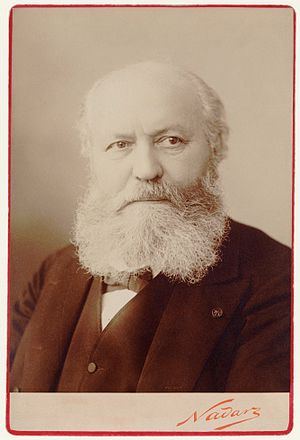
|
Charles Gounod (17 June 1818 – 18 October 1893) was a French composer who wrote twelve operas, the most popular of which is Faust (1859). After studying in Paris, his musical career was launched when he won the prestigious Prix de Rome for composition. Studying at the French Institute in Rome made impressions on him both spiritually and musically that stayed with him for the rest of his life. Back in Paris in 1843, he was appointed chapel master of the church of the Missions étrangères before turning to the theatre. His successful musical career was interrupted by the Franco-Prussian War, and in 1870 he moved to London. By the time he returned to Paris a few years later, he remained a respected figure, but was regarded as old-fashioned and further operatic success eluded him. This photograph of Gounod, dating from 1890, was taken by the French portrait photographer Nadar. Photograph credit: Nadar; restored by Adam Cuerden
Recently featured:
|
June 18
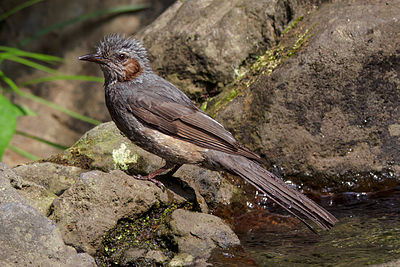
|
The brown-eared bulbul (Hypsipetes amaurotis) is a medium-sized bulbul native to eastern Asia. Reaching a length of about 28 cm (11 in), it is grayish-brown, with brown cheeks (the "brown ears" of the common name), a small spiky crest and a long tail. A bird of the forest canopy, it is also found in plantations, parks and gardens. During the summer, the bird feeds primarily on insects, but in the winter the diet consists mainly of fruits and seeds. In addition, it feeds on nectar from Camellia flowers, becoming dusted with pollen in the process. This brown-eared bulbul was photographed in Tennōji Park in Osaka, Japan. Photograph credit: Laitche
Recently featured:
|
June 19
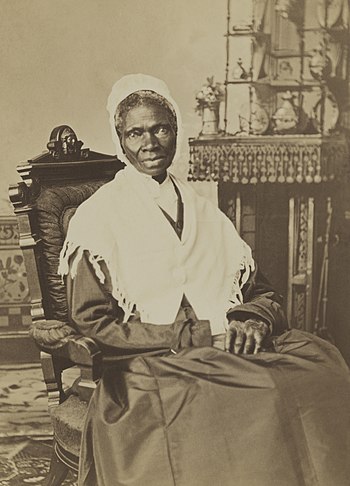
|
Sojourner Truth (c. 1797 – 1883) was an American abolitionist and women's rights activist. Born into slavery in Swartekill, New York, she escaped with her infant daughter to freedom in 1826. After going to court to recover her son in 1828, she became the first black woman to win such a case against a white man. Her original name was Isabella Baumfree; she changed her name to Sojourner Truth when she became a Methodist on Pentecost Sunday, 1843. She chose this name because she heard the Spirit of God calling on her to preach the truth, telling her friends: "The Spirit calls me, and I must go", and left to make her way through the land, preaching about the abolition of slavery. During the Civil War, she helped recruit black troops for the Union Army, and after the war, she tried unsuccessfully to secure land grants from the federal government for former slaves. This photograph of Truth was taken around 1870, accompanied by the caption "I sell the shadow to support the substance", emphasizing her financial acumen. The image is now in the collection of the National Portrait Gallery. Photograph credit: Randall Studio; restored by Coffeeandcrumbs
Recently featured:
|
June 20

|
Jacques Offenbach (20 June 1819 – 5 October 1880) was a German-born French composer, cellist and impresario of the Romantic period. He is remembered for his nearly 100 operettas of the 1850s to the 1870s. The risqué humour (often about sexual intrigue) and the mostly gentle satiric barbs in these pieces, together with Offenbach's facility for melody, made them internationally known, and translated versions were successful in Vienna, London, and elsewhere in Europe. In 1877, he started work on his cherished project, the opera The Tales of Hoffmann, but died before he could complete it. This photographic portrait of Offenbach, dating from sometime in the 1860s, was taken by French photographer Gaspard-Félix Tournachon, who used the pseudonym Nadar; his portraits were notable for their natural poses and the way in which the subject's individual character was brought out. Photograph credit: Nadar; restored by Adam Cuerden
Recently featured:
|
June 21

|
The large red damselfly (Pyrrhosoma nymphula) is a species of damselflies belonging to the family Coenagrionidae. Although called large, it is only 35 mm (1.4 in) long and 15 percent larger than the small red damselfly. This specimen, a mature male photographed at Dry Sandford in Oxfordshire, England, is a mature male; immature individuals of both sexes have yellow shoulder stripes rather than red ones. Mature females come in three different colour forms, but all have yellow bands round their abdominal segments. This species occurs mainly in Europe and is on the wing from April or May onwards. The larvae are found in ponds, lakes and ditches, and take two years to develop before they emerge as adults. Photograph credit: Charles J. Sharp
Recently featured:
|
June 22

|
|
The Inspection is the third of a series of six oil-on-canvas paintings by English painter and pictorial satirist William Hogarth, created around 1743. The series, entitled Marriage A-la-Mode, depicts an arranged marriage and its disastrous consequences in a satire of 18th-century society, and is now in the collection of the National Gallery in London. In this picture, titled The visit to the quack doctor by Hogarth, a young viscount (the son of the bankrupt Earl Squanderfield) is shown visiting a quack doctor. The black patch on the viscount's neck indicates that he has syphilis; he may have brought the young prostitute to the doctor because he believes he has infected her with the disease. The picture has been interpreted in various ways. The doctor is based on Dr Rock, a French doctor with premises at St Martin's Lane, Westminster, and the setting has a wealth of detail of the doctor's consulting room and the tools of his trade. Painting credit: William Hogarth
Recently featured:
|
June 23

|
Ana Santos Aramburo (born 1957) has been the director of the National Library of Spain since February 2013. Having received a degree in geography and history from the University of Zaragoza in Spain, she has spent much of her career working at the Complutense University of Madrid, first at the library of the Faculty of Economics and Business Sciences, and later serving as deputy director of the university library. Later she served as Director of the Historical Library Marquis of Valdecilla, General Director of Libraries and Archives of the City of Madrid, and Director of Cultural Action at the National Library. This photograph of Santos shows her at the headquarters of the National Library of Spain in Madrid. Photograph credit: Biblioteca Nacional de España
Recently featured:
|
June 24

|
The Child's Bath is an 1893 oil-on-canvas painting by American artist Mary Cassatt. She was born in Allegheny City, Pennsylvania (now part of Pittsburgh's North Side), but lived much of her adult life in France, where she first befriended Edgar Degas and later exhibited among the Impressionists. This painting depicts a mother figure and a young child, a genre scene based on the everyday activity of bathing a small child. Cassatt was heavily influenced in her work by some of her fellow Impressionist peers, especially Degas. She also took inspiration from the prints of Japanese woodcuts exhibited at the Académie des Beaux-Arts in Paris, being drawn to the simplicity and clarity of the Japanese designs, and the skilful use of blocks of color. The work is in the collection of the Art Institute of Chicago. Painting credit: Mary Cassatt
Recently featured:
|
June 25
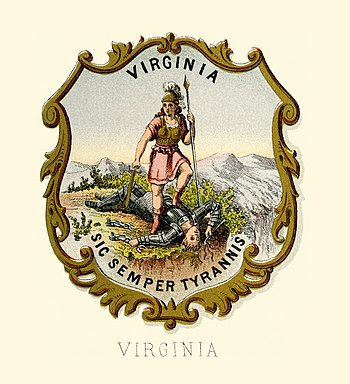
|
Virginia is a state in the Southeastern and Mid-Atlantic regions of the United States. The state capital is Richmond, and Virginia Beach is the most populous city. It was the tenth state to ratify the Constitution of the United States, doing so on June 25, 1788. This picture shows Virginia's historical coat of arms, as illustrated by American engraver Henry Mitchell in State Arms of the Union, published in 1876 by Louis Prang. The escutcheon depicts the Roman deity Virtus, standing in a pose that indicates a battle has been won. She rests on her long spear, and holds a parazonium in her other hand; both are weapons of authority rather than combat. A personification of Tyranny lies defeated at her feet, above the state motto Sic semper tyrannis (Latin for 'thus ever to tyrants'). The broken chain in Tyranny's left hand represents Virginia's freedom from Britain's restriction of colonial trade and westward expansion, and the useless whip in his right hand signifies the state's relief from the punitive laws passed by the British parliament in 1774 after the Boston Tea Party. A similar design appears on the the state's flag and seal. Illustration credit: Henry Mitchell; restored by Andrew Shiva
Recently featured:
|
June 26
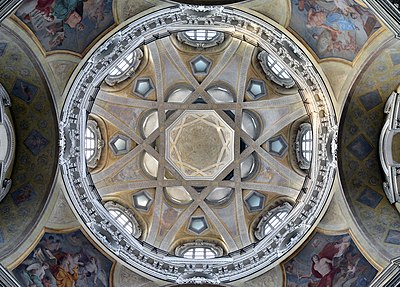
|
San Lorenzo, also known as the Royal Church of Saint Lawrence, is a Baroque-style church in Turin, Italy. The present building was designed and built by the Italian architect Guarino Guarini from 1668 to 1687. This photograph shows the interior of the church's dome, the base of which is circular, although the lantern above it is octagonal. The dome itself is supported by eight ribs forming a lattice similar to those found in mosques and Romanesque churches in Spain. Photograph credit: Livioandronico2013
Recently featured:
|
June 27

|
This montage of nine photographs, ordered from left to right and from top to bottom, shows a cow calving in a garden in Laos. The first photograph shows the restless cow raising her tail and the amniotic sac bulging from the vulva. As she continues to strain, the calf's front feet become visible, and the nose and eventually the whole head emerges; the head is the largest part of the calf, and this part of labour can be protracted. In photographs 3 and 4, the calf's head and forelimbs are visible. The emergence of the body and hind limbs often happens rapidly, either with the cow lying down, as in photograph 6, or when she is standing, as in photograph 7, in which position gravity assists and the calf slithers to the ground. In a normal birth, the calf soon takes its first breaths and the cow starts to lick it. Photograph credit: Basile Morin
Recently featured:
|
June 28

|
Henry VIII (28 June 1491 – 28 January 1547) was King of England from 1509 until his death. This oil-on-panel portrait was painted by Hans Holbein the Younger c. 1537, depicting the king in a near-frontal pose similar to that used by the artist in a number of other portraits. It is a markedly linear picture without background distractions; Henry gazes into the distance, with his head, hands and general demeanour imbuing his personality with a sense of solidity and strength. The painting is in the collection of the Thyssen-Bornemisza Museum in Madrid, Spain. In 1536, Henry suffered a leg injury in a jousting accident. The wound festered chronically for the remainder of his life and became ulcerated, thus preventing him from maintaining the level of physical activity he had previously enjoyed. He became grossly obese, and this hastened his early death; the view that he suffered from syphilis has been dismissed by most historians. Painting credit: Hans Holbein the Younger
Recently featured:
|
June 29

|
The Church of St. Peter and St. Paul is a Catholic church located in the Antakalnis neighbourhood of Vilnius, Lithuania. Constructed between 1668 and 1701, it is the centerpiece of a former monastery complex of the Canons Regular of the Lateran. Its unique interior has masterful compositions of some two thousand stucco figures by Pietro Perti and ornamentation by Giovanni Maria Galli da Bibiena. The church is considered a masterpiece of Baroque architecture in the Polish–Lithuanian Commonwealth. This picture shows the central nave of the church, looking north-eastwards towards the altar and the apse. The nave is dominated by plain white walls that contrast with opulent decorations elsewhere in the church. It is decorated with colorful depictions of the Stations of the Cross and evenly spaced sculptures of the Twelve Apostles, as well as having a number of torture scenes placed within niches featuring martyrs from the persecution of Christians in the Roman Empire. Photograph credit: David Iliff
Recently featured:
|
June 30

|
Jam Gadang is a 26-metre-tall (85 ft) clock tower and major landmark and tourist attraction in the Indonesian city of Bukittinggi, West Sumatra. The structure was built in 1926, during the Dutch colonial era, as a gift from Queen Wilhelmina to the city's controleur. A figure of a rooster was originally placed on the apex, but this was changed into a Shinto shrine–like ornament during the Japanese occupation (1942–1945); following Indonesian independence, the tower's top was reshaped to its present form, which resembles traditional Minang roofs. The tower was damaged in two earthquakes that struck the island in 2007 and was subsequently refurbished. It has been used as an observation post for fire control, and during Ramadan the call to prayer that marks the breaking of the fast is sounded from the tower. Photograph credit: Chris Woodrich
Recently featured:
|
Picture of the day archives and future dates
